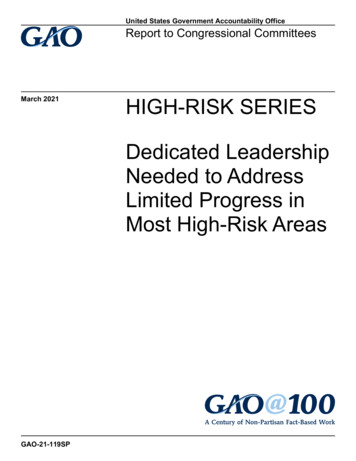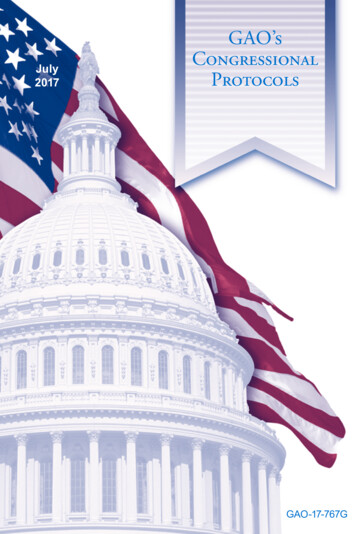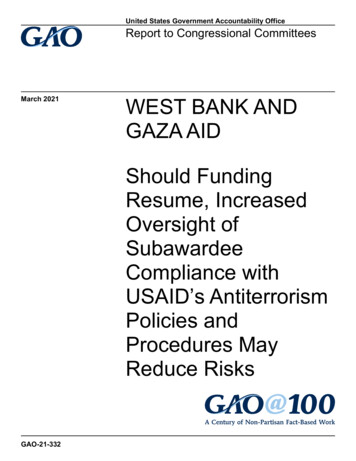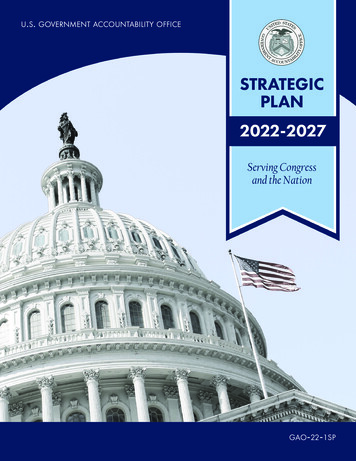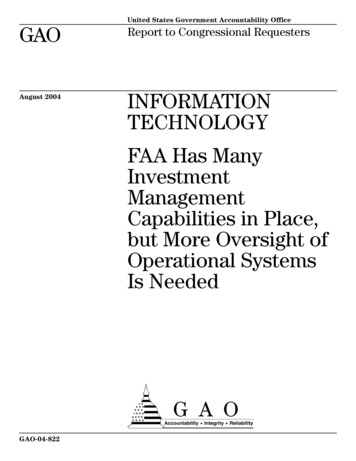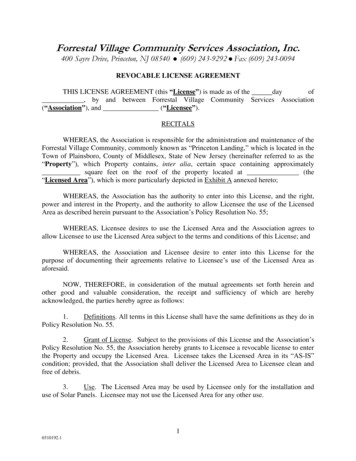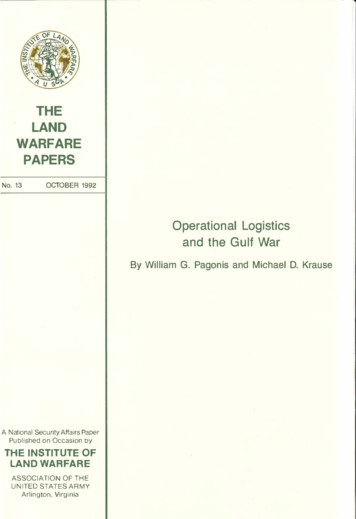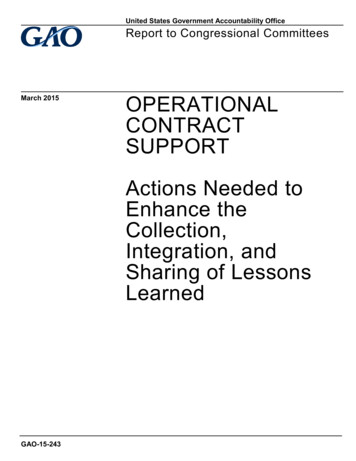
Transcription
United States Government Accountability OfficeReport to Congressional CommitteesMarch 2015OPERATIONALCONTRACTSUPPORTActions Needed toEnhance theCollection,Integration, andSharing of LessonsLearnedGAO-15-243
March 2015OPERATIONAL CONTRACT SUPPORTActions Needed to Enhance the Collection,Integration, and Sharing of Lessons LearnedHighlights of GAO-15-243, a report tocongressional committeesWhy GAO Did This StudyWhat GAO FoundDOD has spent billions of dollars oncontract support during operations inIraq and Afghanistan since 2002 andanticipates continuing its heavyreliance on contractors in futureoperations. Generally, OCS is theprocess of planning for and obtainingneeded supplies and services fromcommercial sources in support of jointoperations. GAO has previouslyidentified long-standing concerns withDOD’s efforts to institutionalize OCS.The Department of Defense’s (DOD) geographic combatant commands areimproving efforts to collect operational contract support (OCS) issues fromoperations and exercises needed to develop lessons learned, but the militaryservices are generally not collecting them. Currently, four of the six geographiccombatant commands—U.S. Africa Command, U.S. Central Command, U.S.Northern Command, and U.S. Southern Command—have identified OCS as acritical capability in their joint training plans and have incorporated it intoplanning, execution, and assessment of exercises, while U.S. EuropeanCommand and U.S. Pacific Command continue to make progress doing so.However, with the exception of the Army, the military services and theircomponent commands are not generally collecting OCS issues to developlessons learned. Officials from the Air Force, Marine Corps, and Navy stated thatthe lack of OCS awareness caused by not having (1) service-wide guidance oncollecting OCS issues and (2) an OCS training requirement for senior leadershinders their ability to develop lessons learned. Without guidance and a trainingrequirement for senior leaders to improve OCS awareness, it will be difficult forDOD to ensure consistent collection of OCS issues and build on efficiencies thatthe services have identified to adequately plan for the use of contractor support.This report examines the extent towhich (1) the geographic combatantcommands and the services collectOCS issues to develop lessonslearned, (2) DOD has a focal point forintegrating OCS issues from the JLLP,and (3) DOD organizations use JLLISto share OCS issues and lessonslearned. GAO evaluated OCS andlessons-learned guidance and plansand met with DOD commands andoffices responsible for OCS planning,integration, policy, and contractormanagement functions.What GAO RecommendsGAO recommends, among otherthings, that DOD and the services (1)issue service-wide OCS lessonslearned guidance; (2) establish anOCS training requirement for seniorleaders; (3) ensure the planned OCSjoint proponent’s roles andresponsibilities include integrating OCSissues from the JLLP; and (4) improveJLLIS’s functionality. DOD concurredwith three of these recommendations,but partially concurred with the thirdrecommendation, stating the need tofirst evaluate its courses of actionbefore establishing such a proponent.GAO believes this recommendation isstill valid, as discussed in the report.View GAO-15-243. For more information,contact Cary Russell at (202) 512-5431 orrussellc@gao.gov.DOD has made progress resolving some OCS issues, but does not have a focalpoint for integrating OCS issues identified through the Joint Lessons LearnedProgram (JLLP). The combatant commands and services are to use the JLLP todevelop lessons learned related to joint capabilities from operations andexercises to improve areas such as doctrine and training. Currently, there aremultiple organizations across DOD that are working on separate and sometimesdisjointed OCS lessons-learned efforts. DOD has undertaken initial efforts toassign an OCS joint proponent with lessons-learned responsibilities. A jointproponent is an entity intended to lead collaborative development and integrationof joint capability. However, DOD has not determined whether the joint proponentwill be responsible for providing formal oversight and integration of OCS issuesfrom the JLLP. As it develops the joint proponent, including such roles andresponsibilities will help better position DOD to integrate all OCS issues from theJLLP, thereby addressing any gaps in its efforts.DOD organizations do not consistently use the Joint Lessons LearnedInformation System (JLLIS) to share OCS issues and lessons learned due to thesystem’s limited functionality. JLLIS is the JLLP’s system of record and is tofacilitate the DOD-wide collection and sharing of lessons learned. However, GAOfound that geographic combatant commands and the Army use JLLIS to varyingdegrees. Further, DOD is generally not sharing OCS lessons learned in JLLISbecause the system is not functional for users searching OCS issues due to,among other reasons, not having an OCS label and not having a designatedlocation for sharing OCS lessons learned. JLLIS’s limited functionality impedesinformation sharing department-wide. Until DOD improves the functionality ofJLLIS, it will be difficult for users to search for OCS issues, and DOD runs therisk of not being able to systematically track and share OCS lessons learneddepartment-wide, which could negatively affect joint force development andreadiness.United States Government Accountability Office
ContentsLetter1BackgroundDOD’s Geographic Combatant Commands Are Improving Effortsto Collect OCS Issues Needed to Develop Lessons Learned,but the Military Services Are Not Generally Collecting OCSIssuesDOD Has Made Progress Integrating Some OCS LessonsLearned, but Lacks a Focal Point for Integrating OCS Issuesfrom the JLLPDOD Organizations Inconsistently Use JLLIS to Share OCSIssues and Lessons Learned Due to Challenges with theSystem’s Limited FunctionalityConclusionsRecommendations for Executive ActionAgency Comments and Our Evaluation25323334Appendix IObjectives, Scope, and Methodology38Appendix IIDOD’s Geographic Combatant Commands and Their Service ComponentCommands44Appendix IIIComments from the Department of Defense46Appendix IVGAO Contact and Staff Acknowledgments49Related GAO Products591950TableTable 1: Locations of the Department of Defense’s (DOD)Geographic Combatant Commands and Their ServiceComponent CommandsPage i44GAO-15-243 OCS Lessons Learned
FigureFigure 1: The Department of Defense’s (DOD) GeographicCombatant Commands’ and Their Respective ServiceComponent Commands’ Areas of partment of DefenseJoint Contingency Acquisition Support OfficeJoint Lessons Learned Information SystemJoint Lessons Learned ProgramOperational Contract SupportThis is a work of the U.S. government and is not subject to copyright protection in theUnited States. The published product may be reproduced and distributed in its entiretywithout further permission from GAO. However, because this work may containcopyrighted images or other material, permission from the copyright holder may benecessary if you wish to reproduce this material separately.Page iiGAO-15-243 OCS Lessons Learned
441 G St. N.W.Washington, DC 20548March 16, 2015Congressional CommitteesSince 2002, the Department of Defense (DOD) has spent billions ofdollars on contract support during operations in Iraq and Afghanistan, 1and anticipates continuing its heavy reliance on contractors to supportongoing and future operations. 2 According to Joint Publication 4-10,operational contract support (OCS) is the process of planning for andobtaining supplies, services, and construction from commercial sources insupport of joint operations. 3 Given the importance of OCS capabilities tocurrent and future operations, the House Armed Services Committeeexpressed its support in 2012 for efforts to collect lessons learned relatedto the full breadth of OCS, noting that past DOD efforts to collect lessonslearned were slowed by a lack of resources and insufficient institutionalsupport. 4Our prior body of work has also demonstrated a need to institutionalizeOCS throughout the department and to collect and review OCS lessonslearned. In December 2006, we found that there was no organizationwithin DOD responsible for developing procedures to systematicallycollect and share its institutional knowledge regarding the use ofcontractors to support deployed forces. 5 We recommended that DODappoint a focal point to, among other things, lead and coordinate thedevelopment of a department-wide lessons-learned program to capture1Commission on Wartime Contracting in Iraq and Afghanistan, Transforming WartimeContracting: Controlling Costs, Reducing Risks (August 2011).2Department of Defense, Operational Contract Support Joint Concept (Oct. 7, 2013).3Joint Chiefs of Staff, Joint Pub. 4-10, Operational Contract Support at GL-8 (July 16,2014) (hereinafter cited as Joint Pub. 4-10 [July 16, 2014]). In a DOD regulation, thedepartment defines operational contract support as the ability to orchestrate andsynchronize the provision of integrated contract support and management of contractorpersonnel providing support to the joint force within a designated operational area. 32C.F.R. § 158.3; Department of Defense Instruction 3020.41, Operational Contract Support(OCS) at 49 (Dec. 20, 2011) (hereinafter cited as DODI 3020.41 (Dec. 20, 2011))4H.R. Rep. No. 112-479, at 187-88 (2012).5GAO, High-Level DOD Action Needed to Address Long-standing Problems withManagement and Oversight of Contractors Supporting Deployed Forces, GAO-07-145(Washington, D.C.: Dec. 18, 2006).Page 1GAO-15-243 OCS Lessons Learned
the experiences of units deployed to locations with OCS. DOD concurredwith our recommendation, and stated that it would develop and implementa systematic strategy for capturing, retaining, and applying lessonslearned on the use of contractor support to deployed forces, as discussedlater in this report. In June 2010, we testified on the need for a culturalchange in DOD that emphasized an awareness of OCS throughout allentities of the department to help address the challenges faced inongoing and future contingency operations. 6 Additionally, in our February2013 report on high-risk areas in the federal government, we reportedthat DOD needed to sustain efforts to integrate OCS through policy,planning, and training for both current and future contingency operations. 7Also, in February 2013, we found that, with the exception of the Army, theother military services (Navy, Marine Corps, and Air Force) had notissued comprehensive service-specific guidance that describes roles,responsibilities, and requirements to help integrate OCS into theirplanning efforts for contingency operations. 8 We recommended that DODfully integrate OCS into contingency planning in the military services, andthe department concurred with our recommendation and took someactions to address it, as discussed later in this report. For a listing ofrelevant past GAO work, see the Related GAO Products list at the end ofthis report.We performed our work for this report under the Comptroller General’sauthority to conduct evaluations on his own initiative, in light ofcongressional interest in DOD’s efforts to institutionalize lessons learnedrelated to OCS. 9 This report examines the extent to which (1) thegeographic combatant commands and the military services collect OCSissues to develop lessons learned; (2) DOD has a focal point forintegrating OCS issues from the Joint Lessons Learned Program (JLLP);6GAO, Warfighter Support: Cultural Change Needed to Improve How DOD Plans for andManages Operational Contract Support, GAO-10-829T (Washington, D.C.: June 29,2010).7GAO, High-Risk Series: An Update, GAO-13-283 (Washington, D.C.: Feb. 14, 2013).Every 2 years at the start of a new Congress, GAO calls attention to agencies andprogram areas that are high risk due to their vulnerabilities to fraud, waste, abuse, andmismanagement, or are most in need of transformation.8GAO, Warfighter Support: DOD Needs Additional Steps to Fully Integrate OperationalContract Support into Contingency Planning, GAO-13-212 (Washington, D.C.: Feb. 8,2013).9See H.R. Rep. No. 112-479, at 187-88.Page 2GAO-15-243 OCS Lessons Learned
and (3) DOD organizations use the Joint Lessons Learned InformationSystem (JLLIS) to share OCS issues and lessons learned.To determine the extent to which the geographic combatant commandsand the services collect OCS issues to develop lessons learned, wereviewed guidance including relevant provisions in part 158 of Title 32 ofthe Code of Federal Regulations, Chairman of the Joint Chiefs of StaffInstruction 3150.25E, 10 Chairman of the Joint Chiefs of Staff Notice3500.01, 11 and Joint Publication 4-10 12 to understand the roles andresponsibilities of DOD entities, including the geographic combatantcommands, the services, and the service component commands,regarding the collection of OCS issues. Additionally, we reviewed militarydepartment and service guidance, such as Army Regulation 11-33, AirForce Instruction 90-1601, Office of the Chief of Naval OperationsInstruction 3500.37C, and Marine Corps Order 3504.1, to identify anyservice-specific policies, guidance, or responsibilities for the collection ofissues. 13 Additionally, we reviewed DOD’s Joint Concept for OCS, whichis intended to guide OCS capability development for the Joint Force 2020.Furthermore, we interviewed OCS and lessons-learned officials from thefour military services, all six geographic combatant commands, and all theassociated military service component commands to discuss their rolesand responsibilities regarding the collection of OCS issues. We visited allsix geographic combatant commands to conduct our interviews withthem.To determine the extent to which DOD has a focal point for integratingOCS issues from the JLLP, we compared the process for the integrationof OCS lessons learned with guidance such as Chairman of the JointChiefs of Staff Instruction 3150.25E, which identifies the primary objective10Chairman of the Joint Chiefs of Staff Instruction 3150.25E, Joint Lessons LearnedProgram (Apr. 20, 2012) (hereinafter cited as CJCSI 3150.25E (Apr. 20, 2012)).11Chairman of the Joint Chiefs of Staff Notice 3500.01, 2014-2017 Chairman’s JointTraining Guidance (Oct. 10, 2013).12Joint Pub. 4-10 (July 16, 2014).13Army Regulation 11-33, Army Lessons Learned Program (ALLP) (Oct. 17, 2006); AirForce Instruction 90-1601, Air Force Lessons Learned Program (Dec. 18, 2013); Office ofthe Chief of Naval Operations Instruction 3500.37C, Navy Lessons Learned System(NLLS) (Feb. 16, 2001); and Marine Corps Order 3504.1, Marine Corps Lessons LearnedProgram (MCLLP) and the Marine Corps Center for Lessons Learned (MCCLL) (July 31,2006).Page 3GAO-15-243 OCS Lessons Learned
of the JLLP—to enhance joint capabilities by contributing toimprovements in doctrine, organization, training, materiel, leadership andeducation, personnel and facilities as well as policy. Additionally, wereviewed the charter for the OCS Functional Capabilities IntegrationBoard, 14 the OCS Action Plan, and DOD Instruction 3020.41, whichidentify responsibilities related to OCS. Additionally, we reviewed DODreports on OCS and lessons learned along with various GAO reports tounderstand DOD’s progress integrating changes in OCS in doctrine,policy, and training, and education. We also interviewed officials whoparticipate in the process for resolving or integrating OCS issues indoctrine, policy, training, and education curriculum—such as those fromthe Joint Staff, military services, Office of the Deputy Assistant Secretaryof Defense for Program Support, OCS Functional Capabilities IntegrationBoard, and Joint Contingency Acquisition Support Office—regarding theextent to which DOD has a focal point for integrating issues from theJLLP. We compared this information to federal internal-control standardsthat state a good internal-control environment requires that the agency’sorganizational structure clearly define key areas of authority andresponsibility and establish appropriate lines of reporting. 15To determine the extent to which DOD organizations use JLLIS—theJLLP’s system of record—to share OCS issues and lessons learned, wereviewed Chairman of the Joint Chiefs of Staff Instruction 3150.25E toidentify the role of commanders with respect to sharing lessons learnedand to identify the system of record for sharing those lessons.Additionally, we participated in a demonstration of JLLIS to understandand observe its capabilities. We also interviewed DOD officials, asdescribed above, about their experiences using JLLIS from 2006, whenthe system was established, through December 2014. Furthermore, weused Chairman of the Joint Chiefs of Staff Instruction 3150.25E andChairman of the Joint Chiefs of Staff Manual 3150.25 16 to understand the14Office of the Under Secretary of Defense (Acquisition, Technology and Logistics)Memorandum, Charter for the Department of Defense Operational Contract SupportFunctional Capabilities Integration Board (June 27, 2014).15GAO, Standards for Internal Control in the Federal Government, GAO/AIMD-00-21.3.1(Washington, D.C.: November 1999).16Chairman of the Joint Chiefs of Staff Manual 3150.25A, Joint Lessons Learned Program(Sept. 12, 2014); Chairman of the Joint Chiefs of Staff Manual 3150.25, Joint LessonsLearned Program (Feb. 15, 2011). CJCSM 3150.25A superseded the earlier version of themanual during the course of our work.Page 4GAO-15-243 OCS Lessons Learned
JLLP phases—discovery, validation, integration, and evaluation. 17 Wecompared this information to federal internal-control standards, whichstate that all significant events should be clearly documented and thedocumentation readily available. 18 To address these objectives, weexcluded from our work procurement-related issues and lessons learnedfrom the acquisition community—for example, contracting officers. 19Additional information about our objectives, scope, and methodology isincluded in appendix I.We conducted this performance audit from March 2014 to March 2015 inaccordance with generally accepted government auditing standards.Those standards require that we plan and perform the audit to obtainsufficient, appropriate evidence to provide a reasonable basis for ourfindings and conclusions based on our audit objectives. We believe thatthe evidence obtained provides a reasonable basis for our findings andconclusions based on our audit objectives.BackgroundDOD Entities with OCSRelated Roles andResponsibilitiesOCS planning, integration, and policy roles and responsibilities, alongwith the associated contractor-management functions, 20 involve all levelsof DOD command and staff, including the following entities:The Under Secretary of Defense for Acquisition, Technology andLogistics has overall responsibility for establishing and publishingpolicies and procedures governing administrative oversight of defensecontracts and for developing and overseeing the implementation of 17For the purposes of this report, the active and passive collection procedures of thediscovery phase are referred to as issue collection.18GAO/AIMD-00-21.3.1.19DOD has a process for conducting pre- and postaward peer reviews for servicecontracts with an estimated value of 1 billion or more. One of the objectives of these peerreviews is to facilitate the sharing of best practices and lessons learned across DOD. SeeDefense Procurement and Acquisition Policy Memorandum, Peer Reviews of Contractsfor Supplies and Services (Sept. 29, 2008).20In the context of OCS, “contractor management” refers to the oversight and integrationof contractor personnel and associated equipment providing support to the joint force in adesignated operational area. 32 C.F.R. § 158.3.Page 5GAO-15-243 OCS Lessons Learned
DOD-level OCS policy. Within this office, the Deputy AssistantSecretary of Defense for Program Support is responsible formonitoring and managing the implementation of OCS policy.The OCS Functional Capabilities Integration Board was created inMarch 2010 and serves as the main forum for the combatantcommands, military departments, and defense agencies to addressOCS capability issues for support to the joint warfighter, to includeassessing and adopting appropriate lessons learned, and solutionsaffecting future contingency operations.The Joint Staff’s Logistics Directorate (J-4) is the primary staffdirectorate on the Joint Staff for OCS matters and is responsible fordeveloping OCS planning policy, related procedures, and templates,as well as ensuring that OCS policies and procedures areincorporated in relevant policy documents and doctrinal publications.J-4 created the Operational Contract Support & Services Division toreflect the increased Joint Staff workload related to institutionalizingOCS.The Defense Logistics Agency is responsible for providing worldwidelogistics support to the military departments and the combatantcommands as well as to other DOD components and federalagencies. It also provides OCS planning, integration, and exercisessupport through its Joint Contingency Acquisition Support Office(JCASO).The Army, Navy, Marine Corps, and Air Force service componentcommands plan and execute OCS for their respective forces inaccordance with guidance from their respective military departmentsand combatant commanders.The six geographic combatant commands, which are supported bymultiple service component commands, play a key role in determiningand synchronizing contracted support requirements and contractingplanning, as well as executing OCS oversight. According to JointPublication 4-10, proper joint-force guidance on common contractsupport–related matters is imperative for facilitating effective andefficient use of contractors in joint operations. 21 In figure 1, we illustrate the six geographic combatant commands’ areasof responsibility and show the locations of the service componentcommands that provide support in each of those areas.21See Joint Pub. 4-10, at II-8 (July 16, 2014).Page 6GAO-15-243 OCS Lessons Learned
Figure 1: Department of Defense’s (DOD) Geographic Combatant Commands and Their Service Component CommandsInteractivity instructions:Roll over the combatant command name to see headquarters locations.See appendix II for the noninteractive, printer-friendly version.U.S. European Command (EUCOM)U.S. Northern Command(NORTHCOM)U.S.CentralCommand(CENTCOM)U.S. SouthernCommand(SOUTHCOM)South PoleU.S. AfricaCommand (AFRICOM)U.S. Pacific Command(PACOM)North PoleNORTHCOMPACOMEUCOMAFRICOMSource: Department of Defense (DOD). GAO-15-243Page 7GAO-15-243 OCS Lessons Learned
DOD’s Joint LessonsLearned Program (JLLP)DOD established the JLLP in 2000 to enhance joint capabilities throughknowledge management in peacetime and wartime. The combatantcommands and the military services are to use the JLLP to developlessons learned related to joint capabilities by collecting issues fromoperations and exercises in order to make improvements to areas suchas doctrine, policy, training, and education. For collected issues,according to CJCS Instruction 3150.25E, the combatant commands andthe military services are to resolve and integrate them at the lowestorganizational level possible, with corrective action taken as close to theissue occurrence as possible. An issue becomes a lesson learned once aDOD entity has implemented corrective action that has contributed toimproved performance or that has increased capability at the strategic,operational, or tactical level.According to Chairman of the Joint Chiefs of Staff Instruction 3150.25E,JLLP knowledge management is enabled by the Joint Lessons LearnedInformation System (JLLIS). 22 As the JLLP’s system of record, JLLIS is tofacilitate the collection, management, and sharing of issues and lessonslearned to improve the development and readiness of the joint force. Anelectronic database, JLLIS is supposed to be used to track progress byDOD stakeholders and other organizations involved in the collection ofissues. Additionally, if an issue is resolved and determined to be a lessonlearned, then it is to be published and shared using JLLIS for properinstitutionalization and learning to improve the operational effectivenessof the joint force. According to Chairman of the Joint Chiefs of StaffInstruction 3150.25E, organizations participating in the JLLP shallcollaboratively exchange information (including issues and lessonslearned) to the maximum extent possible. 23The services have also established service-specific lessons-learnedprograms and processes that include the collecting, integration, andsharing of lessons learned in support of the JLLP. For example, the AirForce Lessons Learned Program allows Airmen from all functional areasto share their observations to help shape how the Air Force prepares forand executes future operations. The Air Force Lessons Learned Programis a “push-pull” process where members of the lessons-learned officescoordinate with functional subject-matter experts to “pull” data and22See CJCSI 3150.25E, encl. A, para. 3 (Apr. 20, 2012).23See id.Page 8GAO-15-243 OCS Lessons Learned
information by conducting interviews and after-action reviews, issuingflash bulletins, and generating formal issues identified. Reports areloaded into JLLIS so that Airmen can track progress and shareknowledge.DOD’s GeographicCombatantCommands AreImproving Efforts toCollect OCS IssuesNeeded to DevelopLessons Learned, butthe Military ServicesAre Not GenerallyCollecting OCSIssuesThe GeographicCombatant CommandsCollect Some OCS Issuesfrom Operations and AreImproving Efforts toCollect OCS Issues fromExercisesDOD’s geographic combatant commands have used large-scaleoperations as sources for collecting OCS issues. For example, in 2012,the U.S. Central Command, with support from JCASO, conductedinterviews to collect issues experienced in OCS activities duringOperation Iraqi Freedom / Operation New Dawn and made 24recommendations within three general areas: contractor management,contract closeout, and transition planning. For instance, in the area oftransition planning, the command found that OCS planning in Iraq wasnot fully integrated into the overall joint task force drawdown or transitionplans. Therefore, the command recommended that OCS planners besourced and embedded with the operations directorate 2 years prior to atransition so that contract support requirements between DOD and theDepartment of State could be properly identified. In Afghanistan, seniorU.S. Central Command and U.S. Forces Afghanistan officials providedobservations and insights about the OCS Integration Cell (formerly thePage 9GAO-15-243 OCS Lessons Learned
OCS Drawdown Cell) 24 and reported having several issues that could beused to inform contractor management and OCS planning. 25 Forexample, the officials reported the need to change the ad hocorganization of the cell, reduce overlap and confusion of duties andresponsibilities, and better integrate contracting support into the planningprocess. In Afghanistan, officials recommended changing the OCSIntegration Cell’s organization and physical location, codifying in doctrinethe OCS Integration Cell authorities prior to a contingency, improvingsharing of OCS-related information with stakeholders, and combiningOCS and operational-contracting functions to improve OCS planning andexecution, among other things.Smaller-scale operations have also provided the geographic combatantcommands with opportunities to collect OCS issues that affect theircommand. For example, U.S. Pacific Command officials observed OCSissues during Operation Tomodachi in 2011, following the earthquake andtsunami near Japan. Specifically, an observation at U.S. PacificCommand recommended that the command establish a Joint TheaterSupport Contracting Command to coordinate contracting during thedisaster, which subsequently led the command to develop an instructionthat includes considerations and procedures for establishing a JointTheater Support Contracting Command and to hold a rehearsal-ofconcept drill. In another smaller-scale operation, Operation UnifiedResponse in Haiti, U.S. Southern Command identified several OCSissues. Specifically, the command identified the need to improve itsSynchronized Predeployment and Operational Tracker policy, 26 developmore OCS capabilities at the military service component commands, andestablish operational frameworks to enable cross-service OCScollaboration within the context of theater security cooperation efforts.24The OCS Drawdown Cell was established in August 2012 with a mission to manage theprogrammatic drawdown of contracts, the contractor workforce, and associated equipmentin the Combined Joint Operations Area–Afghanistan.25JCASO conducted three interviews in early 2014 with senior officials from U.S. CentralCommand and U.S. Forces Afghanistan as part of its Joint Lessons Learned Collection.26Synchronized Predeployment and Operational Tracker is the central data repository forinformation on contracts and contractor personnel in contingency operations. For moreinformation, see GAO, Contractor Personnel Tracking System Needs Better Plans andGuidance, GAO-15-250 (Washington, D.C.: Feb. 18, 2015). U.S. Southern Command’spolicy provides guidance to implement this contractor accountability system duringcontingency and other operations.Page 10GAO-15-243 OCS Lessons Learned
Additionally, the geographic combatant commands are improving effortsto collect OCS issues during exercises. The geographic combatantcommands are to use DOD’s Joint Training System in planning,executing, and assessing joint training, like exercises. 27 The JointTraining System provides an integrated, requirements-based method foraligning joint training programs with assigned missions consistent withcommand priorities, capabilities, and available resources. We have
lessons learned. Officials from the Air Force, Marine Corps, and Navy stated that the lack of OCS awareness caused by not having (1) service-wide guidance on collecting OCS issues and (2) an OCS training requirement for senior leaders hinders their ability to develop lessons learned. Without guidance and a training requirement for senior .
